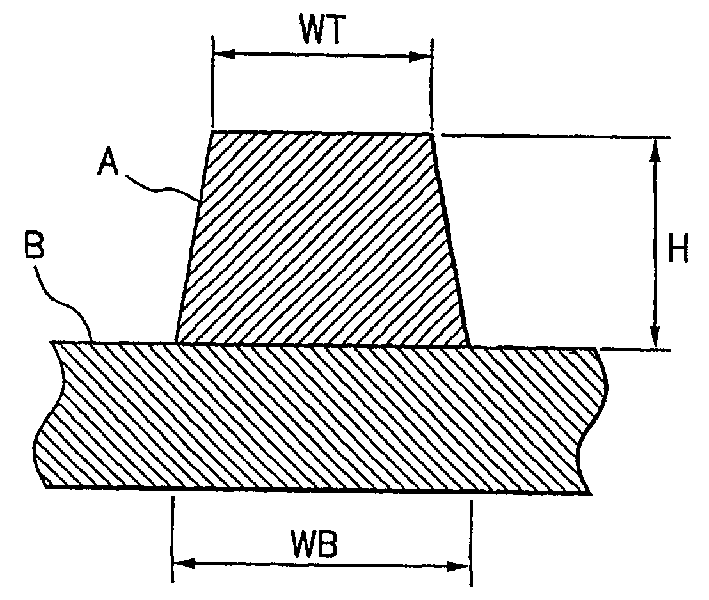Production method of copper foil for fine line use
A technology of fine circuit and copper foil, applied in the direction of printed circuit manufacturing, printed circuit, printed circuit, etc., can solve problems such as open circuit or insulation failure of fine circuit
- Summary
- Abstract
- Description
- Claims
- Application Information
AI Technical Summary
Problems solved by technology
Method used
Image
Examples
Embodiment 1
[0053] (1) Using a 10% sulfuric acid solution, a 12-μm-thick electrodeposited copper foil (surface roughness Rz of the matte side: 1.5 μm measured according to JIS B 0602) was acid-washed in the solution for 20 seconds.
[0054] (2) Then wash the copper foil with water, the matte surface (adhesive surface) of the copper foil is at 3A / dm 2 Electrolytic treatment at current density for 8 seconds in a plating bath containing 50 g / L copper sulfate pentahydrate, 2 g / L sodium molybdate dihydrate, 50 g / L nickel sulfate hexahydrate and 20 mg / liter of chloride ions (if used, hydrochloric acid was used in all examples and comparative examples), the pH of the solution was adjusted to 2.5, the temperature of the plating bath was 30 ° C, and a composite metal containing copper, molybdenum and nickel was formed on the bonding surface of the copper foil layer. The amount of metal coating in the composite metal layer was measured with an ICP (inductively coupled plasma luminescence) analyz...
Embodiment 2
[0061] In the same manner as in Example 1, after acylation and water washing of the same electrolytic copper foil used in Example 1, the matte surface (adhesive surface) of the copper foil was plated at -30°C and the pH was adjusted to 2.0. In bath, at 3A / dm 2 Electrolyze for 8 seconds at current density to form a composite metal layer containing copper, molybdenum, cobalt and iron on the bonding surface of copper foil, the plating bath contains 50 g / L copper sulfate pentahydrate, 2 g / L sodium molybdate Dihydrate, 30 g / L Cobalt Sulfate Heptahydrate, 30 g / L Ferrous Sulfate Heptahydrate, and 40 mg / L Chloride. The amount of metal coating in the composite metal layer was measured with an ICP (inductively coupled plasma luminescence) analyzer, and the copper was 7900 μg / dm 2 , molybdenum is 60μg / dm 2 , cobalt is 12μg / dm 2 , iron 11μg / dm 2 . The roughness Rz of the treated surface was 1.5 μm. Subsequently, in the same manner as in Example 1, a copper-containing roughened layer...
Embodiment 3
[0064] In the same manner as in Example 1, after acylation and water washing of the same electrolytic copper foil used in Example 1, the matte surface (adhesive surface) of the copper foil was plated at -30°C and the pH was adjusted to 2.5. In bath, at 4A / dm 2 Electrolyze for 6 seconds at current density to form a composite metal layer containing copper, molybdenum and zinc on the bonding surface of copper foil, the plating bath contains 50 g / L copper sulfate pentahydrate, 2 g / L sodium molybdate dihydrate substance, 50 g / L zinc sulfate heptahydrate and 5 mg / L chloride ion. The amount of metal coating in the composite metal layer was measured with an ICP (inductively coupled plasma luminescence) analyzer, and the copper was 7900 μg / dm 2 , molybdenum is 130μg / dm 2 , zinc is 20μg / dm 2 . The roughness Rz of the treated surface was 1.5 μm. Subsequently, in the same manner as in Example 1, a copper-containing roughened layer was formed. Copper content in the roughened layer is...
PUM
| Property | Measurement | Unit |
|---|---|---|
| thickness | aaaaa | aaaaa |
| surface roughness | aaaaa | aaaaa |
| surface roughness | aaaaa | aaaaa |
Abstract
Description
Claims
Application Information
 Login to View More
Login to View More - R&D
- Intellectual Property
- Life Sciences
- Materials
- Tech Scout
- Unparalleled Data Quality
- Higher Quality Content
- 60% Fewer Hallucinations
Browse by: Latest US Patents, China's latest patents, Technical Efficacy Thesaurus, Application Domain, Technology Topic, Popular Technical Reports.
© 2025 PatSnap. All rights reserved.Legal|Privacy policy|Modern Slavery Act Transparency Statement|Sitemap|About US| Contact US: help@patsnap.com


